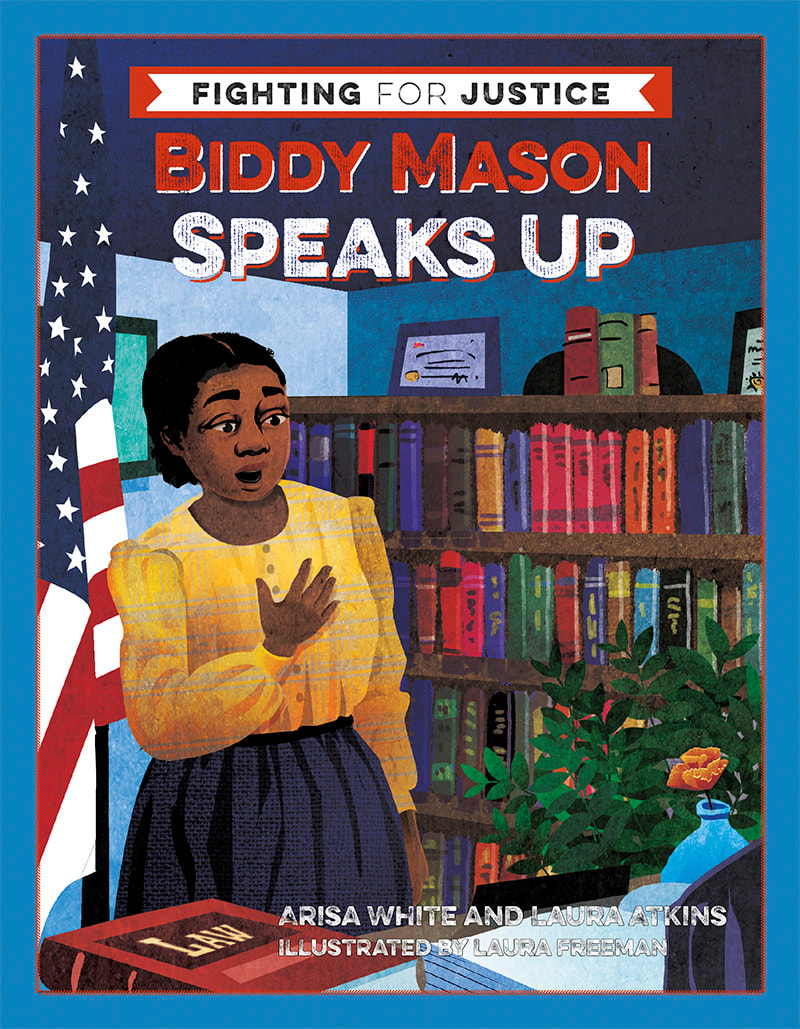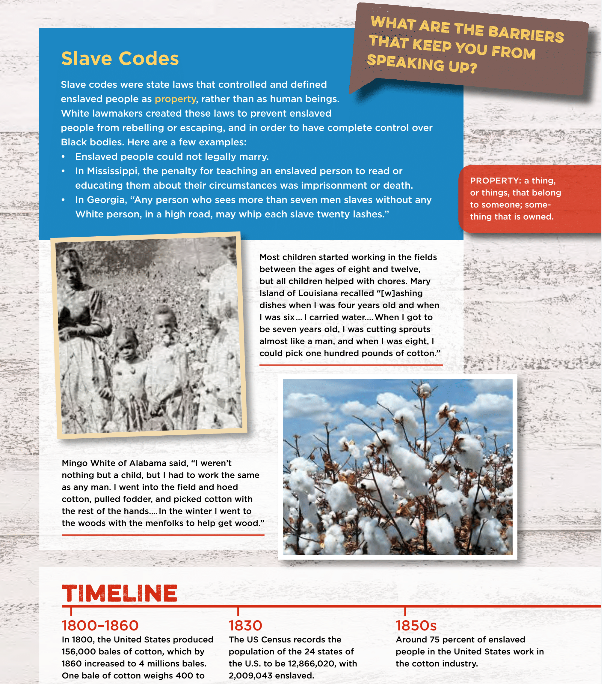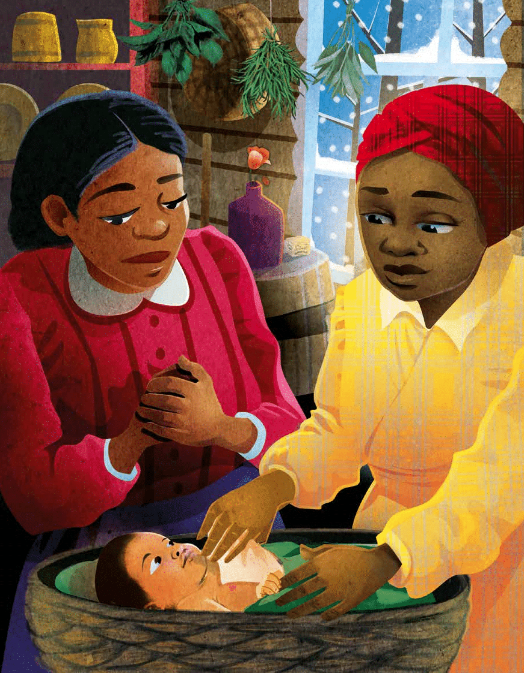|
White, Arisa and Laura Atkins. (2019). Biddy Mason Speaks Up. Illustrated by Laura Freeman. 112 pgs. Heyday, Berkeley, CA. Grades 5 - 8 Biddy Mason Speaks Up, the second title in the Fighting for Justice series, is intriguing, direct, and impossible to put down. The book tells the little known story of Biddy Mason, a 19th century midwife and herbalist who traveled Westward as an enslaved person, gained her freedom through the support of an active network of community members, and became an integral part of Los Angeles’s first Black community. Biddy’s story unfolds in increments throughout the book, each two to three-page episode setting the stage for a chapter packed with historical narrative, definitions, timelines, and photographs, which lend context to the biographical story. The storyline is told in verse - short, simple sentences set against a pastel background accompanied by vibrant digital illustrations by Laura Freeman (Hidden Figures, Harper Collins, 2018). Each informational section addresses a theme introduced in the story such as plantation life, the economy of slavery, resistance, homesteading, and community building. Native plants used in healing and midwifery are featured throughout the text, adding a naturalist component that enriches the context. Educators will find merit in the layout as well as the content. Text boxes, captions, primary sources, definitions, and timelines support information literacy and research skills. The interplay of verse and informational text appeals to multiple literacies and the variety of content will entice readers with many interests. Fans of graphic novels and Guiness record books will be drawn in by the plethora of photographs, facts, and text boxes. Acknowledgments, source notes, bibliography, credits, and an index solidify the book as a nonfiction source. Liberties taken in the verse are explained in the informational sections as based on research. Uncomfortable concepts like enslavement, profiteering, and rape are respectfully approached with age-appropriate clarity, which will prompt meaningful discussion. Among many defining attributes, the Fighting for Justice series (Fred Korematsu Speaks Up, 2017) forges a meaningful connection between history and present day society. Readers are encouraged to apply the meaning of each chapter to their own experience through thoughtful prompts like, “What are the barriers that keep you from speaking up?”. Back matter includes a section titled “Healing Your Community: From Biddy’s Day to Ours”. The series breaks the paradigm of traditional U.S. history texts for children, which propagate white privilege by omitting or editing historical fact. Details like using the term “enslaved person” in place of “slave” humanizes historical figures and pays respect to their descendants. The creators’ holistic approach to presenting history is inclusive, refreshing, and irresistible. As a youth services professional, I appreciate the thoroughness of the content, the focus on a lesser-known figure and geographical location, and the interplay of story and documentation. The poetry accompanied by Freeman’s vibrant illustrations provide an artistic perspective of Biddy’s story that captures the intensity and emotion of her circumstances. Many readers will appreciate the opportunity to indulge in the pictures and storyline that precedes each informational section of the book. The contrast between prose and documentation allows readers to absorb information in multiple formats, which increases stamina and leads to deeper comprehension.
Photographs and illustrations dating from the 19th century are presented alongside legal documents and maps. Definitions in the sidebars provide a deeper understanding of highlighted key words within the narrative. Timelines connect Biddy’s experience with broader historical narratives like the abolition movement and the removal of Native Peoples. Through this smorgasbord of documentation, White and Atkins demonstrate the depth of evidence needed to fully understand the impact of slavery both in a historical context and in modern day society. Immersing oneself in these pages of documentation is akin to visiting a museum in which each artifact brings us closer to a greater understanding about the topic and ourselves. Not only does the book inform, it also questions. Through thoughtful, well-placed prompts, the authors invite readers to interact with the information by making a personal connection. In chapter seven, we learn that despite a California state law that forbids slavery, freedom for people of color was rarely enforced and slave owners continued to hold people captive. It was only through the efforts of Black community members and advocates that enslaved people eventually gained freedom. A speech bubble in this chapter asks, “how can you and your friends support one another and those facing injustice?”. Such questions teach reflection, a practice that will prove invaluable as young readers move forward academically, and become thinking members of their communities. When learning is personal, so is it memorable. The focus on Biddy Mason as the protagonist further sets the book apart from the myriad of historical texts for middle-grade readers. By delegating the portrayal of slavery in America to a relatively small cast of historical figures like Harriet Tubman and Frederick Douglas, the literary world has limited the scope of its repercussions. Biddy’s story suggests that she is but one of millions whose story has been omitted if not erased from the American narrative. I found myself asking the question, “Why have I not heard this story?” and contemplating how many more stories I may have been denied by a traditional American education. Of particular interest is the abundance of information on California as a new state. The role of Black residents, Native Peoples, and Mexican-Americans played in its rapid development is too-often under-stated by traditional history texts that uphold settlers of European descent as its primary characters. Biddy’s creators present an inclusive history in which we learn of Mexican American vaqueros and Black cowboys, Afro-Mexican civic leaders, and the area’s first people, the Tongva. Readers of every age will come away from Biddy Mason Speaks Up with an enriched perspective about history and a better understanding of its impact on our society today. As a parent, I thank White and Atkins from the bottom of my heart for offering a gateway and guide for talking truthfully with my children about the world in which we live. My eleven-year-old son and I enjoy reading together and the right books lead to powerful conversations I struggle to initiate otherwise. Zetta Elliot’s Bird (2008, Lee & Low) helped us talk about addiction. Lois Lowry’s The Giver (1993, Double Day) led to conversations about constructs and conformity. Biddy Mason invites us to confront white supremacy, and to explore equality and feminism together in a meaningful way. I answered my son’s questions from my heart, but I used the information in the book as a guide and a tool. Prompts like “Who is resisting injustice today, and what can you do to support them?” led to discussions about campaigns like Black Lives Matter and the Me Too movement. We talked about bullying. We talked about sexual harassment. We talked about white supremacy. It wasn’t so much that we read the book, as we experienced the book together. Biddy Mason Speaks Up invites us to be vulnerable and to discuss our society - past and present - with an open mind and an open heart. Many historical books for middle grade readers take a colonialist approach to educating, attempting to sooth white guilt by offering excuses or incomplete explanations for the ugliness of the past. Or by simply writing history off as being in the past. It’s done, it’s over, let’s move on. Rather than erecting a wall between past and present, White and Atkins immerse readers in the naked truth with simple but poignant explanations. Within this place of honesty and vulnerability, they invite readers to connect this past with their own reality. A text box titled “Power Discussed” asks us to reflect on how we see power in our community and explores the word itself and permutations like institutional power, collective power, and empowerment. Chapter three explores the economy of slavery, dispelling the common textbook myth that the North was unanimously against it. "The system of slavery was woven into all the parts of the United States, and people across the country benefited from it. Slave owners made money from the work of enslaved people. Slave traders made money from the people they sold. Owners of ships and railroads made money trafficking humans across water and land. Enslaved people built roads, dams, homes, and public buildings. The United States became a wealthy, prosperous country because of the labor of enslaved people" (p. 20). Chapter three also provides an honest look at slavery and genealogy, a topic integral to Biddy’s story. The inset explains that slavery was matrilineal, meaning that if a mother was enslaved, her child was enslaved. “Enslaved women could sometimes partner and have children with enslaved men. Masters could also rape enslaved women. Enslaved people did not have a choice about how their bodies were used, since they were seen as property” (p. 21). A supplemental text box defines rape as “When one person forces a sexual act on another person who does not want it or who is unable to give consent” (p. 21). Direct explanations like these encourage questions and link the atrocities of the past with current campaigns for equality and justice. The Fighting for Justice books explain to our children why things aren’t fair. But they also uplift and empower, proving through their protagonists that ordinary people can speak up. Biddy Mason Speaks Up invites young readers to join a conversation, to reflect, and to make connections. It is powerful in its intimacy and memorable for its honesty. Most of all, the book empowers. The Fighting for Justice series lays a foundation of knowledge and provides the questions that will fuel the change makers of tomorrow.
0 Comments
Leave a Reply. |
Archives
May 2020
Categories |



 RSS Feed
RSS Feed
